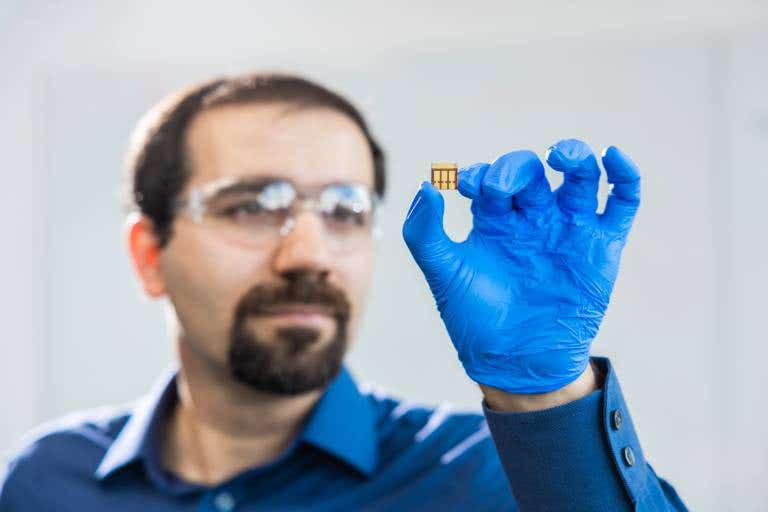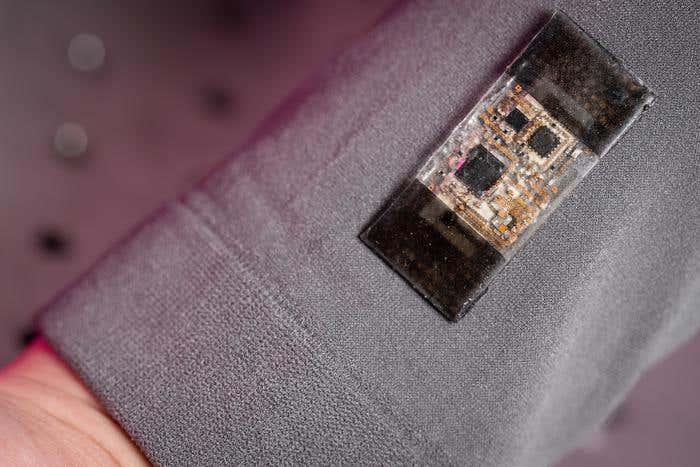Scientists create indoor solar cells that could eliminate billions of batteries
Breakthrough perovskite indoor solar cells could power billions of devices without batteries, offering record efficiency and durability.

Associate Professor Mojtaba Abdi-Jalebi with a small prototype of photovoltaic cells optimized for indoor light. (CREDIT: UCL / James Tye)
In a world where billions of connected devices—from smart thermostats to wireless sensors—demand small amounts of energy, battery replacements have become a wasteful and costly habit.
Scientists from University College London, working alongside partners in China and Switzerland, believe they’ve found a solution that could keep many of those gadgets running indefinitely without swapping out batteries. Their approach centers on newly engineered perovskite solar cells, designed specifically to harvest energy from everyday indoor lighting with record-breaking efficiency and long-term durability.
A New Take on Solar for Indoor Use
Unlike traditional silicon solar panels, which are best suited for bright outdoor sunlight, perovskite cells can be fine-tuned to absorb the softer, narrower range of wavelengths emitted by indoor light sources like LEDs and fluorescents. The challenge has been making them both efficient and stable. Imperfections in their crystal structure—tiny flaws known as traps—can snag electrons and waste energy as heat. Over time, these defects also cause the material to break down, reducing performance.
The research team tackled this issue using what they call a “Triple Passivation Treatment” (TPT), a carefully chosen combination of three chemicals: rubidium chloride, N,N-dimethyloctylammonium iodide, and phenethylammonium chloride.
Together, these additives encourage the perovskite crystals to grow more evenly. The additives reduce internal strain, stabilize key ions, and prevent the crystals from clumping into separate phases that harm performance. In essence, they smoothed the path for electrons to move freely, boosting the cell’s ability to turn light into electricity.
Lead author Siming Huang likened the improvement to fixing a broken cake: “The solar cell with these tiny defects is like a cake cut into pieces. Through a combination of strategies, we have put this cake back together again, allowing the charge to pass through it more easily.”
Related Stories
- The future of solar power is clear—literally
- Scientists create high-efficiency solar cells that work best indoors and low-light spaces
Efficiency and Durability Set New Records
The results speak for themselves. Under lighting conditions equivalent to a bright office (about 1000 lux), the cells achieved an indoor power conversion efficiency of 37.6%—a world record for perovskite devices designed for indoor use. That’s roughly six times better than the best commercial indoor solar cells currently on the market.
Equally important, these cells hold up over time. In storage tests at room temperature and low humidity, they retained 92% of their performance after more than four months. Even under harsher conditions—continuous light at 55°C for 300 hours—they maintained 76% of their initial output. Comparable untreated devices, by contrast, dropped to less than half of their starting performance.
Powering the Internet of Things Without Batteries
The implications are enormous for the rapidly growing Internet of Things. As senior author Dr. Mojtaba Abdi Jalebi points out, “Billions of devices that require small amounts of energy rely on battery replacements – an unsustainable practice. This number will grow as the Internet of Things expands.” With these high-efficiency cells, small electronics in homes, offices, and factories could draw steady power from ambient light without human intervention.
The manufacturing process is another advantage. Perovskite cells can be made using abundant materials at relatively low temperatures, and even printed in a process similar to newspaper production. That combination of scalability, low cost, and high efficiency has the researchers in active talks with industry partners about bringing the technology to market.
If commercialized, these cells could redefine how we think about powering small electronics—turning the light in your living room, office, or factory floor into a continuous, maintenance-free energy source.
Past Studies and Findings
Previous work on indoor photovoltaics has explored organic semiconductors and dye-sensitized cells, but these technologies often suffer from lower efficiencies and shorter lifespans compared to the latest perovskite designs. Early generations of perovskite indoor solar cells showed promise, but they were plagued by rapid degradation due to ion migration and crystal defects, with operational lifespans measured in weeks or months.
Researchers have also experimented with varying the bandgap of perovskites to better match indoor light spectra, achieving modest gains in performance. However, stability has remained a persistent challenge, limiting their commercial viability.
Practical Implications of the Research
The breakthrough could enable a new class of self-sustaining electronics, from environmental sensors and security alarms to medical monitoring devices. Without the need for frequent battery changes, this technology could lower maintenance costs, reduce e-waste, and improve sustainability. It may also support innovation in smart homes and industrial automation by enabling continuous operation of devices in places where battery replacement is impractical.
In the long run, indoor light harvesting could play a role in building-wide energy efficiency strategies, where every lumen of artificial light serves a dual purpose—both illumination and power generation.
Research findings are available online in the journal Advanced Functional Materials.
Note: The article above provided above by The Brighter Side of News.
Like these kind of feel good stories? Get The Brighter Side of News' newsletter.



